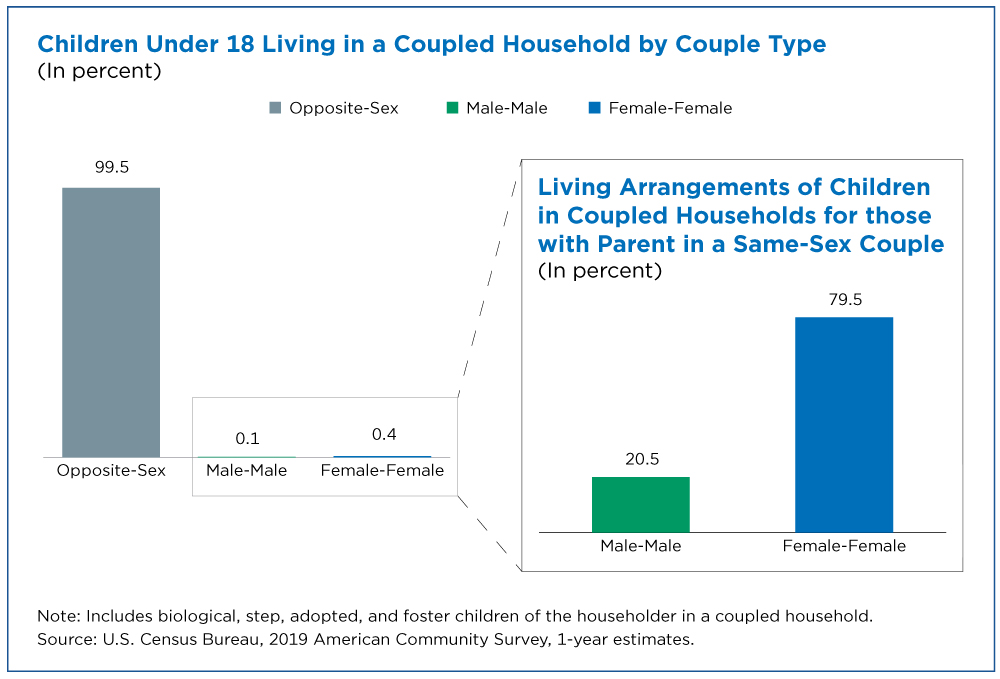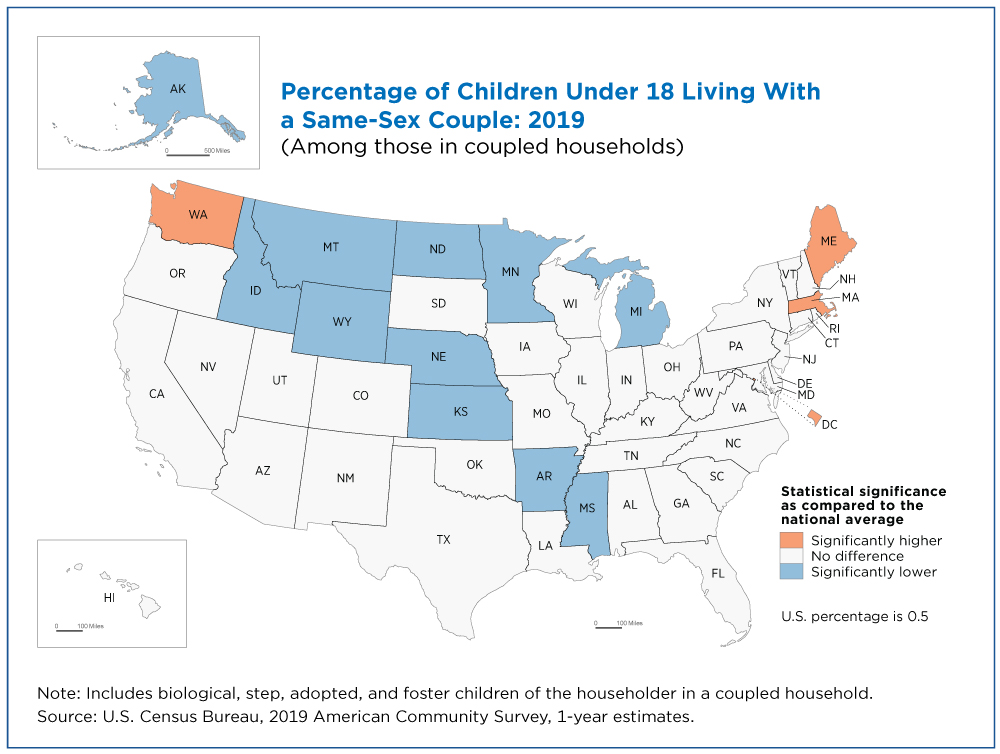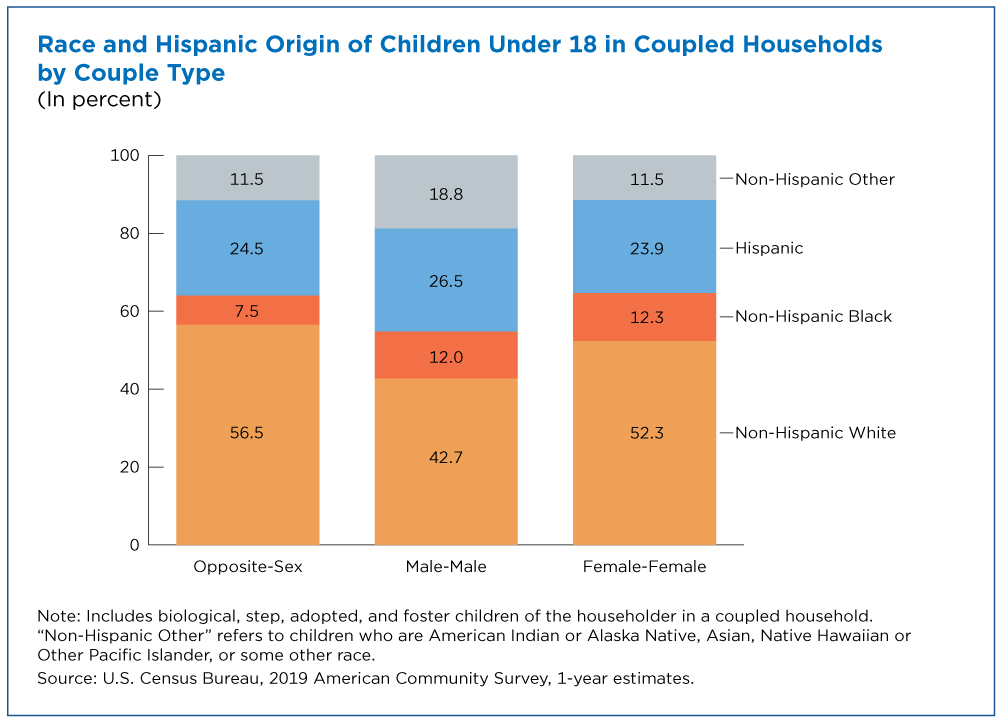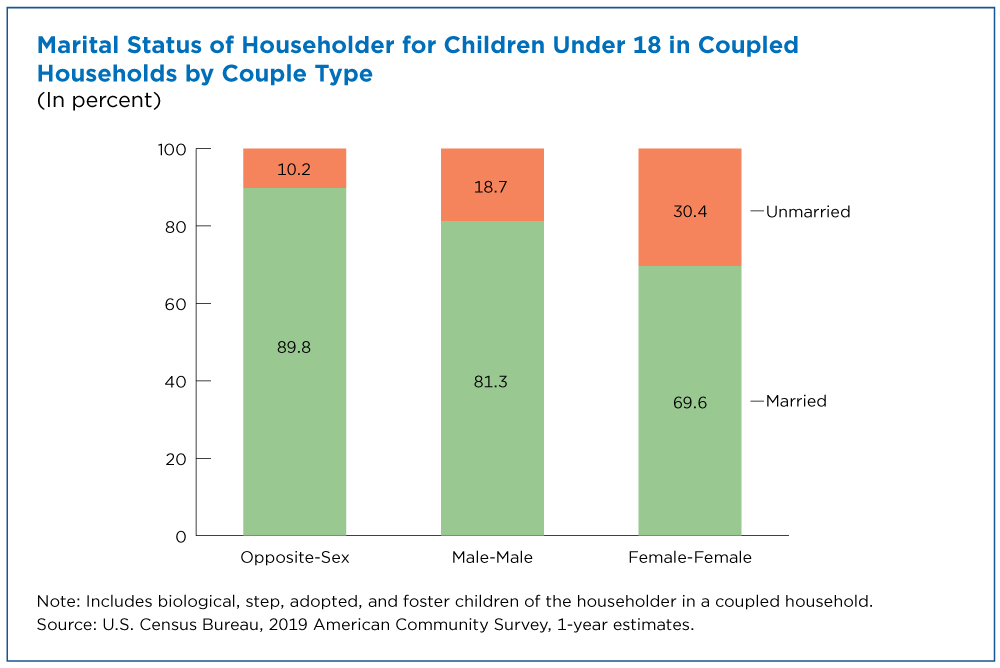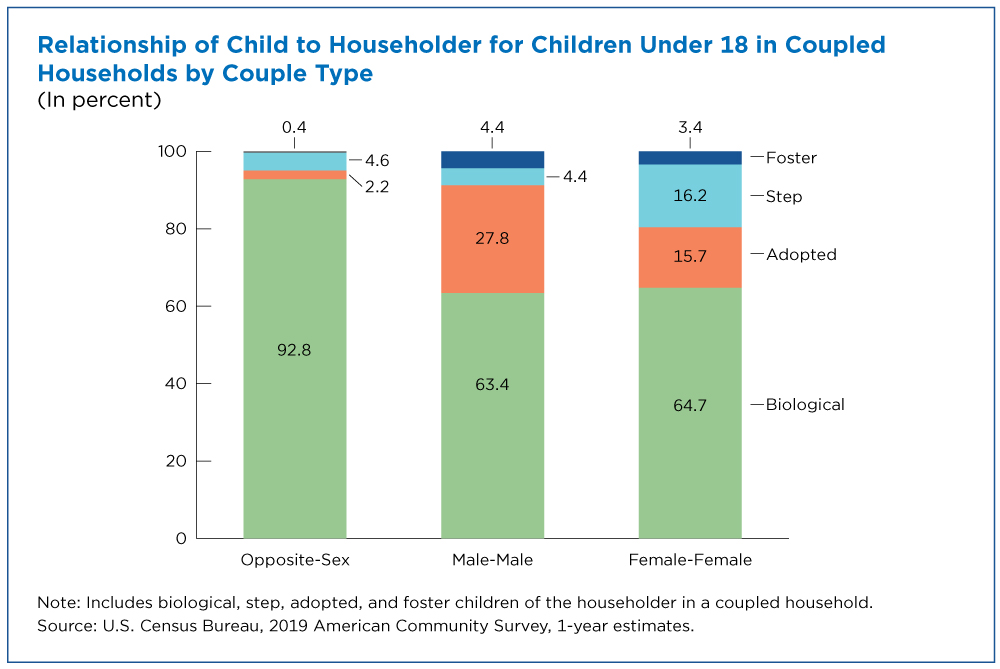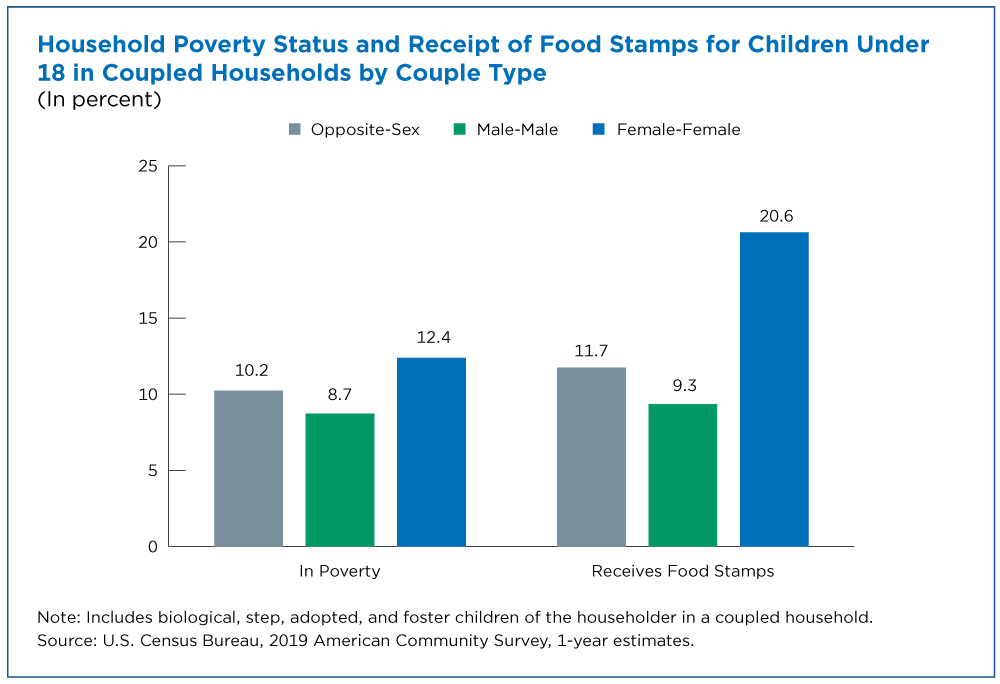Children of Same-Sex Parents More Likely to Be Adopted Than Those Living With a Parent in an Opposite-Sex Relationship
Children of a householder living with a same-sex spouse or partner were more likely to be non-Hispanic Black, and less likely to live with a married parent than children living with a householder parent in a male-female relationship.
Recent 2019 American Community Survey (ACS) data provide national estimates of children living with a householder parent in a same-sex relationship. A householder is someone who owns or rents the home that receives the survey. A householder parent can report biological, step, adopted, or foster children under 18 living with them.
While the majority of children under age 18 in a coupled household lived with an opposite-sex couple in 2019 (99.5%), 4 in 5 (79.5%) children living with a same-sex couple lived with a female parent and their female partner or spouse.
About the Data
While multiple people may own or rent the home, the ACS only allows for one respondent to indicate that they do so. The spouse or unmarried partner of the householder parent may also be the biological, step or adoptive parent of the child, but the ACS does not measure this relationship.
Descriptions of “parent(s)” throughout the story refer only to householder parents. As a result, there are children of same-sex couples who are not represented in this story. For example, people under 18 who are not reported as the child of the householder are not included here.
Children living in their grandparent’s home, for instance, would not be considered as living with a householder parent if the grandparent is the householder. Furthermore, married and unmarried couples are grouped together (unless specified otherwise) to provide enough statistical power, but combining these couples could mask some variation between the two groups.
Despite the limitations of ACS data, this story offers an opportunity to compare the characteristics of children of same- and opposite-sex couples. The large sample size in the ACS provides a sufficient number of responses to allow for statistical comparisons and analysis of children with same-sex parents.
Children in Same-Sex Couple Households
While the majority of children under age 18 in a coupled household lived with an opposite-sex couple in 2019 (99.5%), 4 in 5 (79.5%) children living with a same-sex couple lived with a female parent and their female partner or spouse.
Geographic Differences
Nationally, 0.5% of children living in coupled households lived with a householder parent in a same-sex relationship.
- In the majority of states, the percentage of children living with a parent in a same-sex relationship did not differ from the national average.
- Three states (Maine, Massachusetts and Washington) and the District of Columbia had a significantly greater share of children living with a parent in a same-sex relationship than the national average.
- Eleven states — Alaska, Arkansas, Idaho, Kansas, Michigan, Minnesota, Mississippi, Montana, Nebraska, North Dakota, and Wyoming — had a significantly lower percentage of children living with a parent in a same-sex relationship.
Race and Hispanic Origin of Children
- Significantly fewer children with a householder parent in a male-male relationship were non-Hispanic White than children living with a mother in a same-sex relationship or a parent in an opposite-sex relationship.
- Children with a parent in a same-sex relationship were more likely to be non-Hispanic Black than those with a parent in an opposite-sex relationship.
- The percentage of children who were Hispanic did not significantly differ across three types of coupled households (opposite-sex, male-male, and female-female).
- Children whose parent was male and lived with a male partner/spouse were more likely to be non-Hispanic Other than children with a parent in an opposite-sex relationship or those with a female parent in a same-sex relationship. Non-Hispanic Other refers to children who are American Indian or Alaska Native, Asian, Native Hawaiian or Other Pacific Islander, or some other race.
Marital Status of Parent
- Nearly 9 in 10 children who lived with a householder parent who was in an opposite-sex relationship had a married parent, while living with a married parent was less likely for children with a mother or father in a same-sex relationship.
- Among children with a father in a same-sex relationship, 8 in 10 had a married father, whereas 7 in 10 children living with a mother in a same-sex relationship had a married mother.
Relationship to Parent
The relationship between children and their householder parent also differed according to couple type:
- The majority (93%) of children with a parent in a male-female relationship were the biological child. But among children with a parent who had a same-sex partner/spouse, only around two-thirds were biologically related to the parent for whom the ACS collects the detailed type of relationship.
- Children with a father in a same-sex relationship were more likely to be adopted than children in the other two living arrangements. However, it is important to recognize that the other parent may be the biological parent, as one member of a same-sex couple often has to legally adopt the child, unlike opposite-sex couples.
- Among those with a mother in a same-sex relationship, children were more often the stepchild of the householder than those with a parent in an opposite-sex relationship or those with a father in a same-sex relationship. Again, it is important to remember that the other parent may be the biological parent, and the prevalence of a relationship like stepchild may be affected by who is listed as the householder.
Poverty and Food Stamps
- Among children living with a mother who had a same-sex partner or spouse, 12% lived in a household with an income (in the past 12 months) below the poverty level, compared to 9% of those with a father in a same-sex relationship and 10% of those with a parent in a male-female relationship. However, the percentages of children living below the poverty level did not significantly differ across these three living arrangements.
- Although the percentage of children living in a household in poverty did not differ, significantly more children living with a householder mother in a same-sex relationship lived in a home that received food stamps (21%), compared to about 12% of children living with parents in an opposite-sex relationship and about 9% of children with fathers in same-sex relationships.
- The percentage of children with a father in a same-sex relationship who received food stamps was not statistically different from the percentage with a parent in an opposite-sex relationship.
More information on confidentiality protection, methodology, sampling and nonsampling error, and definitions is available on this technical documentation page.
Related Statistics
-
Stats for StoriesNational Spouses Day: January 26, 2024According to the Current Population Survey 2023 ASEC Supplement, there are some 133.1M married adults age 15+ in the U.S., not counting 4.6M who are separated.
-
Stats for StoriesNational Child's Day: November 20, 2023In 2021, the majority (71%) of America’s 72.3M children under 18 lived with two parents and the next largest share (20.9%) lived with their mothers only.
-
Stats for StoriesNational Parents’ Day: July 23, 2023Of the 63.2M parents living with their children <18, 76.1% lived with a spouse, 15.1% had no spouse/partner present. The rest lived with a cohabiting partner.
Subscribe
Our email newsletter is sent out on the day we publish a story. Get an alert directly in your inbox to read, share and blog about our newest stories.
Contact our Public Information Office for media inquiries or interviews.
Related America Counts Stories
-
America Counts StoryHow Do People in Same-Sex Couples Compare to Opposite-Sex Couples?April 01, 2021A U.S. Census Bureau interactive data visualization shows characteristics of same-sex couples at the state level.
-
America Counts StoryFifteen Percent of Same-Sex Couples Have Children in Their HouseholdSeptember 17, 2020Male same-sex couples are more likely to adopt children than female same-sex couples.
-
Business and EconomyEconomic Census Geographic Area Statistics Data Now AvailableApril 07, 2025A new data visualization based on the 2022 Economic Census shows the changing business landscape of 19 economic sectors across the United States.
-
Income and PovertyWhat Sources of Income Do People Rely On?April 02, 2025A new interactive data tool shows income sources for hundreds of demographic and economic characteristic combinations.
-
Business and EconomyBig Improvements to the Annual Integrated Economic Survey (AIES)March 26, 2025The Census Bureau is making several changes and enhancements to capture 2024 economic data based on feedback from last year’s survey.
-
PopulationOnly 50 U.S. Counties Had Populations Over a Million in 2024March 17, 2025A new data visualization highlights U.S. counties between 1970 and 2024 whose populations ever surpassed a million.



